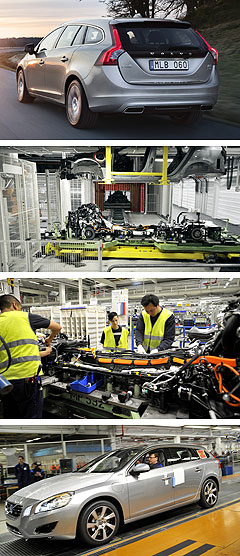Volvo turns up wick on plug-in V60
BY RON HAMMERTON | 20th Nov 2012

The Swedish company expects to build between 4000 and 6000 of the vehicles in the new model year – at least quadruple the number built in the initial trial batch of 1000 units for the current model year.
For Volvo Car Australia, this means a good chance of securing stocks of the vehicle within 2013, probably in the second half.
VCA public affairs manager Oliver Peagam said the V60 PHEV was still not confirmed for Australia, but the company still had its hand up for it.
“We are still going through the whole process,” he said. “As we have said before, we have certainly put our hand up for it and are very keen to get it here as soon as possible.”Mr Peagam said the decision to ramp up production at Volvo’s Torslanda plant, in the company’s home town of Gothenburg, was good news for Australia as it improved the chances of approval for this country.
Unlike other plug-in hybrid vehicles such as the Holden Volt, the V60 PHEV is built on the same production line as the standard V60 and S60.

Areas of the final assembly line had to be rebuilt to accommodate the process, which involves an extra 300 parts covering the electric powertrain and battery.
The diesel engine, electric motor, transmission, control units and wiring are all assembled on a pallet along with the front and rear chassis, and then the body is lowered on top.
The lithium-ion battery pack is then maneuvered in through the rear hatch and rotated to drop it into its housing in the wagon’s floor.
The 11.2kWh 400-volt battery has sufficient power to propel the V60 for 50km on electric power, driving through the rear wheels, before the five-cylinder diesel engine kicks in, driving the front wheels.
Volvo Car Corporation senior vice-president of research and development Peter Mertens said Volvo was the first company to integrate a plug-in vehicle into the regular assembly line.
“The integration in the standard production flow gives the plug-in hybrid buyer the possibility to choose in principle all options available for the standard V60,” he said.
The first 1000 vehicles were all pre-sold in Europe, and Volvo says orders are already flooding in for the next batch.
The V60 PHEV can achieve a class-leading 1.9 litres per 100km on the European official fuel economy combined test cycle, yet can accelerate from zero to 100km/h in 6.2 seconds – equal with the current fastest V60, the turbocharged T6.
The plug-in V60, which was shown in concept form at the Australian International Motor Show in Melbourne last year, is set to become VCA’s first electrified car, as the company did not offer the all-electric C30 DRIVe that was leased to customers in Europe.
The V60 PHEV is expected to become the flagship of the V60 range, with a price premium above the current most expensive model, the $78,490 T6 R-Design, despite a luxury car tax discount of about $7000 due to its low fuel consumption.
Although the V60 PHEV will create waves as a halo car when it arrives in Australia, VCA first will launch an even more important vehicle – the new V40 small car – in February.